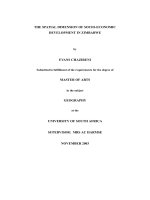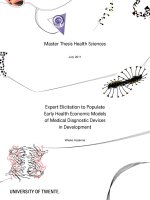spectral resonance of nanoscale bowtie apertures in visible wavelength
Bạn đang xem bản rút gọn của tài liệu. Xem và tải ngay bản đầy đủ của tài liệu tại đây (262.12 KB, 5 trang )
DOI: 10.1007/s00339-007-4125-3
Appl. Phys. A 89, 293–297 (2007)
Materials Science & Processing
Applied Physics A
l. wang
x. xu
✉
Spectral resonance of nanoscale bowtie
apertures in visible wavelength
School of Mechanical Engineering, Purdue University, West Lafayette, IN 47907, USA
Received: 29 March 2007/Accepted: 2 May 2007
Published online: 21 June 2007 • © Springer-Verlag 2007
ABSTRACT We report spectroscopic measurements of transmit-
ted field through bowtie-shaped nanoscale apertures in visible
wavelength region. Resonance in these apertures and its rela-
tion with the aperture geometry are investigated. The near-field
spectral response is also investigated using finite difference time
domain (FDTD) computation and compared with the spectro-
scopic measurements. The dependences of the peak wavelength
and peak amplitude on the geometry of the bowtie aperture are
illustrated. Design rules are proposed to optimize the bowtie
aperture for producing a sub-wavelength, high transmission
field.
PACS 81.07 b; 07.79.Fc; 71.36.+c; 78.66Bz; 42.79.Gn;
42.79.Vb
1 Introduction
Light transmission through a nanoscale aperture
in a metallic film allows a confined spot to be produced in
the near field. Producing a nanoscale light spot has drawn
much attention in recent years as a nanoscale light spot can
be used in many applications requiring high spatial resolution
such as single molecule detection [1], nanofabrication [2]
and high density data storage [3]. However, using a simple
nanometer-sized hole in circular or square shapes is plagued
by its low transmission and poor contrast [4]. The low trans-
mission through regular nanoapertures can be ascribed to the
waveguide cutoff effect. It is known that the fundamental cut-
off wavelengths for the waveguides with circular and square
cross sections are
1.7d and 2d,whered is the diameter of the
circular waveguide or theside length of the square waveguide,
respectively. A sub-
100 nm circular hole will be subjected to
the cutoff conditions under UV or visible light illumination;
therefore, light cannot be efficiently coupled through. This
drawback limits regular nanoapertures from being employed
in many applications.
Many efforts have been made to improve the transmis-
sion efficiency through sub-wavelength apertures while main-
taining their near-field confinement function. One approach
is to take advantage of the enhancement of localized sur-
✉ Fax: 1-765-494-0539, E-mail:
face plasmon by introducing a minute scatter in the center
of a regular aperture [5]. Although this approach promises
sub-diffraction-limited resolution, sub-
100 nm near-field ra-
diation is yet to be demonstrated [6]. Another approach fol-
lows the similar mechanism of transmission enhancement
through a hole array in noble metal films [7] or using a circu-
lar aperture surrounded by a periodic ring corrugations (bull’s
eye pattern) [8] so that the transmission can be enhanced at
selected resonant wavelengths.
Recently, it is demonstrated that high transmission effi-
ciency and confined nanoscale radiation can be obtained sim-
ultaneously by using nanoscale bowtie aperture [9–11]. Com-
pared to regularly shaped nanoapertures, it has been numer-
ically and experimentally demonstrated that bowtie apertures
are capable of providing a nanometer-size near-field spot as
well as enhanced transmission orders of magnitude higher
than regularly shaped apertures [9–11]. The unique proper-
ties of bowtie nanoapertures as shown in Fig. 1 are endowed
by their specially designed geometries: two open arms and
a nanometer-size gap. When illuminated by an excitation
source with proper polarization – in the direction across the
gap, the open arms allow longer cutoff wavelengths while
the gap size determines the size of the transmitted light spot.
The transmitted field through the bowtie apertures is not
only confined, but also greatly enhanced compared to regular
nanoapertures operated under the cutoff conditions. Utiliz-
ing these apertures in the visible regime, however, presents
several design, fabrication, and experimental challenges. In
this report we study the resonance of bowtie apertures in the
visible region. Bowtie apertures with various shapes are in-
vestigated using both spectral measurements and numerical
methods, and the results of spectral measurements and calcu-
lations are compared.
2 Experimental approach
Bowtie apertures were fabricated using an FEI
Strata DB 235 FIB (focused ion beam) tool. A cleaned
150-mm-thick aluminum film was deposited on quartz wafer
by e-beam deposition. The apertures were then formed in the
aluminum film by ion milling with
30 keV focused Ga
+
ions
at
1pAbeam current. The gap size should be as small as pos-
sible because the light spot produced by the bowtie aperture is
determined by its gap size [9]. However, the smallest gap size
294 Applied Physics A – Materials Science & Processing
FIGURE 1 SEM pictures of fabricated bowtie
apertures
that can be practically fabricated using our FIB tool is about
30 nm due to the limitations of finite ion beam size. Thin alu-
minum film of
150 nm thick is selected because of its small
skin depth and high reflectivity. SEM pictures of three bowtie
apertures of
180 nm, 200 nm,and280 nm outline dimension
andasamegapsizeof
33 nm are shown in Fig. 1.
Investigation of the spectral responses of nanoapertures
is important for understanding their behavior [7, 8, 12], and
would allow determination of the resonance wavelength and
optimization of their performance for a tailored application.
Figure 2 shows a simplified schematic of the experimental
setupusedinthisworkforthefar-field spectral transmission
measurement. A tunable laser output from an optical para-
metric amplifier (OPA) pumped by an amplified ultrafast laser
system is used as the light source. The laser beam is focused
onto the sample using a condenser lens with numerical aper-
ture
NA =0.15. The transmitted laser light through nanoaper-
tures in the sample is collected by a
50× objective and dir-
ected onto a photomultiplier tube. To collect single-aperture
transmission, a
50 µm pinhole was placed in the image plane
FIGURE 2 Schematic diagram of far field measurement setup
of the objective, defining the spatial resolution of about 1 µm.
The individual apertures were spaced
15 µm apart to limit
coupling among apertures, and to ensure that transmitted light
was collected solely from one aperture. The sample was raster
scanned, and recorded by the PMT signal readout. The power
throughput of each nanoaperture in different wavelengths can
therefore be compared by the photon counts after spectral cal-
ibration.
3 Simulation
It is well known that Fourier optics is no longer ad-
equate for analyzing optical properties and responses in real
metals due to the finite skin depth, film thickness, and pos-
sible surface plasmon effect [13]. Instead, vigorous vectorial
analysis must be applied. The finite difference time domain –
FDTD numerical method first introduced by Yee in 1966 [14]
can be used to simulate the optical near filed of light transmis-
sion through subwavelength apertures by numerically solving
the Maxwell’s equations. In the FDTD algorithm, the compu-
tational region is discretized into small cubes, called Yee cells.
Each cell has a dimension of
∆x, ∆y,and∆z in Cartesian
coordinates with size less than tenth of wavelength to ensure
accurate numerical results. However, in the study of the near
field of nanostructures, the cell size should be much smaller
than the smallest dimensions of nanostructures to ensure the
physical convergence, especially when the field quantities in
the vicinity of the nanostructure is of interest. In this work
4×
4 ×4nm
3
cells are used to model bowtie nano-apertures. The
stability condition relating the spatial and temporal step size is
used, which is expressed as
v
max
∆t =
1
∆x
2
+
1
∆y
2
+
1
∆z
2
−1/2
, (1)
where v
max
is the maximum velocity of the wave in the ma-
terial. In addition, absorbing or perfectly matched boundary
conditions [15, 16] are employed to eliminate the reflected
waves on the boundaries of the finite computational domain.
The second-order absorbing boundary condition [16] is used
in this work. The commercial software package XFDTD 5.3
from Remcom is used, which has been used in many near field
calculations [9,10].
The modified Debye model is used to compute the com-
plex permittivity for aluminum, which is expressed as
ε(ω) = ε
∞
+
ε
s
−ε
∞
1 + jωτ
+
σ
jωε
0
, (2)
where
ε
s
represents the static permittivity, ε
∞
is the permit-
tivity at infinite frequency which should be no less than 1,
σ
WANG et al. Spectral resonance of nanoscale bowtie apertures in visible wavelength 295
is conductivity, and τ is the relaxation time. Given the experi-
mental refractive index data of aluminum in the wavelength
range of interest [17], the parameters in the Debye model
are found as
ε
∞
= 1, ε
s
=−507.825, τ = 9.398 ×10
−16
s,
and
σ = 4.8 ×10
6
s/m. The simulated geometry consists of
a
150 nm thick aluminum film and a semi-infinite quarts
layer. The wavelength of incident light varies from
400 nm
to 800 nm and the polarization of the light is in the direction
across the gap of bowtie apertures. The index of refractive
used for the quartz is 1.5.
4 Results and discussion
It is well known that light scattering of metal-
lic nanoparticles and apertures have strong geometry depen-
dence [5–7]. In this report we focus our study on the res-
onance in the visible wavelength range. Figure 3 shows the
measured transmission through three bowtie apertures of dif-
ferent outline sizes:
180 nm, 200 nm and 280 nm as a function
of the illumination wavelength. A resonant peak is found in
the visible wavelength range for all three apertures. The trend
of the spectrum response also indicates that there is another
resonant peak in the near infrared region. However, this sec-
ond resonant peak is not be measured since our experimental
system only provides the wavelength range as indicated in
Fig. 3, which is limited by the response of the photomultiplier
tube. From the figure it can be seen that the larger bowtie aper-
ture has a resonant peak at longer wavelength, indicating the
red shift of the resonant wavelength with respect to the bowtie
aperture outline dimension. In addition, the amplitude of the
peak response also increases as the aperture outline dimen-
sion increases. This is simply because more light is able to be
coupled through for a larger aperture.
Far-field and near-field spectra of a
180 nm bowtie aper-
ture with a
32 nm gap are simulated and normalized to its
peak value as shown in Fig. 4. The far field is calculated as
the integral of the transmitted power at a distance
300 nm
from the aperture exit; whereas the near field is the inten-
sity at at the center of the aperture on the exit plane. From
the figure it is found that the far-field and near-field spectra
have the same resonant wavelength and follow the same trend,
but the far field transmission is slightly lower than the near
FIGURE 3 Power throughput of bowtie apertures of three different sizes in
150 nm aluminum film as a function of illumination wavelength
field transmission at longer wavelengths. Figure 5 compares
the calculated near-field spectra of three bowtie apertures of
the same dimensions as experimentally measured apertures.
Comparing the calculated results with the measurement data,
it can be seen that the simulated spectral curves follow the
same trendas the experimentalresults: thereis a resonant peak
in the visible wavelength range for each aperture, and there is
also a resonance peak in the infrared range as seen from the
trend of the calculated curve. The numerical calculation also
predicts a red shift when the bowtie aperture size increases.
On the other hand, the resonant positions of thecalculated and
measured resonance peaks do not exactly coincide with each
other, which can be due to the difficulties in precisely meas-
uring and modeling the actual aperture dimensions and the
inaccuracy in the optical properties of the material.
The calculated amplitude of the peak response increases
as the aperture outline size increase, which is also predicted
by the experimental results. FDTD simulated field intensity
distribution of
180 nm outlinedimension bowtie aperturewith
32 nm gap size at the resonant wavelength of 525 nm is shown
in Fig. 6a, showing a strong field at the exit of the aperture. On
the other hand, as shown in Fig. 6b at the non-resonant wave-
length of
400 nm, the light intensity is much smaller. At the
resonance, the aperture acts as a resonant cavity and provides
the most efficient transmission from the entrance to the exit.
FIGURE 4 The far-field and near-field transmission spectra of bowtie aper-
tures with outline of 180 nm
FIGURE 5 The near-field spectra of bowtie apertures in various outline
sizes: 180 nm, 200 nm and 280 nm
296 Applied Physics A – Materials Science & Processing
FIGURE 6 FDTD simulated field intensity dis-
tribution of the 180 nm outline dimension bowtie
aperture with 32 nm gap size at the excita-
tion wavelengths of (a) 525 nm (resonance) and
(b) 400 nm (non-resonance)
The calculated shortest resonant wavelength as a func-
tion of the outline dimension is further illustrated in Fig. 7.
A
120 nm outline size bowtie aperture with a 32 nm gap was
also simulated. A linear relation can be seen in the figure, with
a
0.75 nm red-shift of the resonant wavelength per 1nmin-
crease in the aperture size. Practically, due to the fabrication
limitations thesmallest outlinesize of bowtie aperture thatcan
be fabricated is about
150 nm. Therefore the shortest wave-
length that the resonant peak can occur is about
503 nm.On
the other hand, in order to obtain the confined light, the out-
line size of the bowtie aperture has to be less than about half of
the wavelength so thattransmission is confinedwithin the gap.
Calculations show that when the wavelength is larger than
608 nm, the outline dimension becomes larger than the half
wavelength. This leads to a maximum resonant wavelength of
about
608 nm.
To illustrate the effect of the gap size of the bowtie aper-
ture, the near-field spectra of bowtie apertures with various
gap sizes are also calculated and shown in Fig. 8. Three gap
sizes of
24 nm, 32 nm and 48 nm are compared. The other di-
mensions for the three bowtie apertures are kept the same:
200 nm outline dimension, and 152 nm film thickness. It can
be seen that resonantwavelength does not changewith the gap
size. This indicates that the resonant cavity which provides
the most efficient transmission is decided by the outline di-
mension of the bowtie aperture. However, it is found that the
field intensity becomes stronger at the smaller gap size. The
transmitted field can be considered as induced by the dipole
radiation at the two bowtie tips. As the gap size reduces, the
FIGURE 7 The change of resonant wavelength as a function of the outline
size of bowtie aperture
charge density increases due to the stronger coupling between
the two tips and the near-field strength therefore increases.
Based on the above results, we can obtain the design rules
for achieving both high transmission and high resolution in
the visible wavelength range. First, the gap size needs to be
fabricated as small as possible to achieve the best resolution
which also helps to increase the near field transmission. The
smallest gap size can be fabricated by FIB tool is about
30 nm.
Then for wavelength range between
503 and 608 nm, the out-
line dimension can be fabricated to achieve resonant transmis-
sion. However, forother wavelengths since resonantcondition
cannot be met, its outline dimension needs to be tuned to find
the maximum transmitted field. As an example, Fig. 9 shows
FIGURE 8 The near-field spectra of bowtie apertures in various gap width:
24 nm, 32 nm and 48 nm gap
FIGURE 9 The near-field intensity of bowtie apertures in various outline
dimensions at 800 nm incident wavelength
WANG et al. Spectral resonance of nanoscale bowtie apertures in visible wavelength 297
the transmission intensity as a function of outline size when
the gas size fixed at
32 nm and the wavelength is at 800 nm.
It is found that the maximum transmitted field occurred at
a
150 nm outline dimension.
5Conclusion
In summary, spectroscopic measurements of light
transmission through bowtie-shaped apertures fabricated in
aluminum film are performed. The spectral responses of three
bowtie apertures of different outline dimensions and same gap
size are experimentally obtained using a polarized tunable
laser as the excitation source. Resonant far-field transmission
is observed and the resonance is red-shifted when the overall
size of the bowtie aperture increases. FDTD numerical com-
putations are conducted and the near-field radiation spectra
show similar trend as the far-field radiation measurement. We
also found that the resonance does not change as the gap size
between two bowtie tips decreases, but the amplitude of the
near-field resonant response increases when the gap size de-
creases. For wavelength between about 500 and
600 nm,the
bowtie aperture can be fabricated to match a desired reson-
ance wavelength. For other wavelengths, the size of bowtie
apertures can be tuned to find the highest transmission.
ACKNOWLEDGEMENTS The financial support to this work
by the Nation Science Foundation is acknowledged. Fabrications of aperture
samples and NSOM probes by FIB were carried out at the Birck Nano-
technology Center, Purdue University.
REFERENCES
1 E. Betzig, R.J. Chichester, Science 262, 1422 (1993)
2 I.I. Smolyaninov, D.L. Mazzoni, C.C. Davis, Appl. Phys. Lett. 67, 3859
(1995)
3 E. Betzig, J.K. Trautman, R. Wolfe, E.M. Gyorgy, P.L. Finn, M.H. Kry-
der, C.H. Chang, Appl. Phys. Lett. 61, 142 (1992)
4 H. Bethe, Phys. Rev. 66, 163 (1944)
5 K. Tanaka, T. Ohkubo, M. Oumi, Y. Mitsuoka, K. Nakajima, H. Hosaka,
K. Itao, Japan. J. Appl. Phys. 40, 1542 (2001)
6 K.Tanaka,H.Hosaka,K.Itao,M.Oumi,T.Niwa,T.Miyatani,Y.Mit-
suoka, K. Nakajima, T. Ohkubo, Appl. Phys. Lett. 86, 83 (2003)
7 T. Ebbesen, H. Lezec, H. Ghaemi, T. Thio, P. Wolff, Nature 391, 667
(1998)
8 H. Lezec, A. Degiron, E. Devaux, R. Linke, L. Mart
´
ın-Moreno,
F. Garc
´
ıa-Vidal, T. Ebbesen, Science 297, 820 (2002)
9 E.X. Jin, X. Xu, Japan. J. Appl. Phys. 43, 407 (2004)
10 E.X. Jin, X. Xu, Appl. Phys. Lett. 86, 111106 (2005)
11 L. Wang, S.M. Uppuluri, E.X. Jin, X. Xu, Nano Lett. 6, 361 (2006)
12 J.A. Matteo, D.P. Fromm, Y. Yuen, P.J. Schuck, W.E. Moerner, L. Hes-
selink, Appl. Phys. Lett. 85, 648 (2004)
13 J.W. Goodman, Introduction to Fourier Optics (McGraw-Hill, New
York, 1996)
14 K. Yee, IEEE Trans. Antennas Propag. 14, 302 (1966)
15 G. Mur, IEEE Trans. Electromagn. Compatibility 23, 377 (1981)
16 Z.P. Liao, H.L. Wong, B. Yang, Y. Yuan, Sci. Sin. 28, 1063 (1984)
17 D.R. Lide, CRC Handbook of Chemistry and Physics, 77th edn. (CRC
Press, Roca Raton, 1996), p. 12









